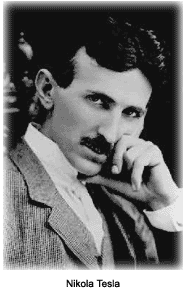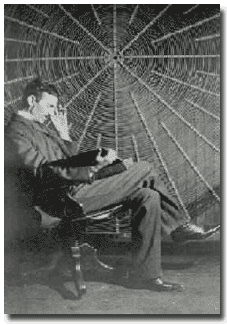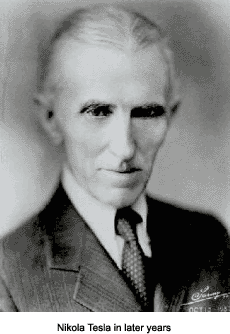Nikola Tesla was a brilliant visionary, physicist, inventor and electrical engineer of the late 19th and early 20th centuries. He is most famous for having invented the alternating current (AC) electrical system. The AC system, also known as the “Polyphase AC System," includes alternating current, AC generators, motors and a power transmission system. They comprise a complete system of generators, transformers, transmission lines, motors and lighting, upon which the modern world is built.
 Early Life
Early Life
Nikola Tesla was born at midnight, July 9, 1856 in Lika, Croatia. Tesla’s parents were Serbian. His father was a stern Orthodox priest, gifted writer and poet. The father’s desire was for Nikola to enter the priesthood. Tesla's mother was a woman of many talents who created, among other things, a mechanical eggbeater. Tesla’s creative instincts evidently sprang from his mother.
Tesla was educated at the Austrian Polytechnic School at Graz and the University of Prague, Czechoslovakia, where for four years he studied mathematics, physics and mechanics. Endowed with a remarkable memory, Tesla learned to speak six languages and could perform calculus equations mentally while still a student. Not only did he possess a photographic memory, he was able to use creative visualization with an uncanny yet practical intensity. The unit of “Magnetic Flux Density” is officially called a “Tesla."
Tesla Arrives in America
Tesla arrived in New York at age 28, nearly penniless, with a letter of recommendation addressed to Thomas Edison, for whom he worked a short time. Edison’s DC power station in Lower Manhattan had strung sagging wires throughout the district, which was hungry for electric light.* Tesla quickly improved Edison’s systems, but Edison refused to pay him the promised $50,000. Tesla quit.
Approached by a group of investors while digging ditches to support himself, Tesla received funding to perfect a low-cost arc lamp. While the invention was successful and the investors made money, Tesla ended up with no pay and a stack of worthless stock certificates.
AC versus DC
A.K. Brown of the Western Union Company agreed to invest in Tesla's idea for an AC motor. In a small room a short distance from Edison's office, Tesla opened his first of several laboratories. He successfully constructed and patented his AC Polyphase Electrical System. Tesla’s superior AC system directly competed with Edison’s DC system.
Edison, being more famous and better connected, fought to discredit Tesla’s inventions and success. Tesla won the most important battles, but Edison won the propaganda war. That may explain why relatively little is written or taught about Tesla to this day.
The AC system comprises seven patents awarded to Tesla in November and December of 1887. So original were the ideas that the patents were issued without a successful challenge, and would turn out to be among the most valuable patents of all time.
In 1885, George Westinghouse, head of the Westinghouse Electric Company, (Edison and General Electric’s chief competitor), bought the patent rights to Tesla's system of dynamos, transformers and motors. Westinghouse used Tesla's alternating current system to light the World's Columbian Exposition of 1893 in Chicago.
The Tesla Coil, invented in 1891, is still in use today, stepping up household electrical current to very high frequencies and voltages. High frequencies allowed Tesla to develop the first neon and fluorescent illumination, and the first X-Ray photographs. The Coil is also used in radio and television sets, and such other electronic equipment as computer monitors. Other Tesla inventions include the automobile speedometer and ignition system.
Such names as Thomas Edison, Alexander Graham Bell, Guglielmo Marconi and Albert Einstein are more familiar a century later, but the achievements of Edison, Bell and Marconi remain in the practical world only. The sole similarities between Tesla and Edison were that both men were driven and focused upon their work and both required little sleep.
Both Tesla and Einstein described their thought processes as more visual than word based. For his part, Edison said of his own mental processes, "Genius is one percent inspiration and 99 percent perspiration."
 Tesla's Legacy
Tesla's Legacy
Some historians of science believe Tesla ranks in the same class as Albert Einstein and Leonardo daVinci. Like daVinci, Tesla is credited with both practical and theoretical accomplishments. Among Tesla’s 325 world patents, plus physics theories, are some of the fundamental technologies and ideas of the 20th century, and seeds for the future achievements of the human race.
Wireless transmission of energy became Tesla’s lifelong obsession when, in 1890, he discovered he could light a vacuum tube through the air at a distance. He wrote in Century Magazine in 1900:
"...communication without wires to any point of the globe is practicable. My experiments showed that the air at the ordinary pressure became distinctly conducting, and this opened up the wonderful prospect of transmitting large amounts of electrical energy for industrial purposes to great distances without wires . . . its practical consummation would mean that energy would be available for the uses of man at any point of the globe. I can conceive of no technical advance which would tend to unite the various elements of humanity more effectively than this one, or of one which would more add to and more economize human energy."Practical applications of Tesla’s AC electrical and radio broadcast patents brought modern science and engineering to the technological age. They form the world’s “power grid," and lie at the root of all the following technologies: robotics, radio and television broadcasting, remote control, radar and hybrid-fuel automobiles. Tesla's bladeless disk turbine engine, when coupled with modern materials, proved to be among the most efficient motors ever designed.
Tesla’s inventions and discoveries led to the latest in laser and particle-beam weaponry, and may resolve the looming world oil crisis. Answers to Tesla’s theoretical questions are as elusive as Einstein’s “Theory of Everything," yet promise real technological advances when technology catches up.
Examples of advanced applications and ongoing research, based on Tesla’s patents and theories, include remote control of pilotless spy drones, and NASA’s planetary missions using such robots as the little “Rover” on Mars.
Secret or “black” projects based upon Tesla’s work include Ronald Reagan’s “Star Wars” defense shield, which became the “Shiva” project, and Electromagnetic Low Frequency (ELF) weather modification, in which the ionosphere is charged by radio wave transmissions in the low frequency range of 10 to 80 hertz.
Tesla also discovered that he could cause both positive and negative ionization of the atmosphere by manipulating radio frequencies. Evidence indicates that this technology also has the capability to manipulate human behavior and mood patterns.
 Late Life
Late Life
Nikola Tesla died alone and nearly penniless on January 7, 1943, in a New York City hotel room. He was 86 years old. More than 2,000 people attended the funeral. Tesla’s papers and notebooks were retained by the federal government's Alien Property Custodian office, most of which were released years later to the newly created Tesla museum in Belgrade, Yugoslavia. Many of Tesla’s experiments and achievements were recorded only in Tesla’s mind, and they died with him.
In July 1934, Tesla wrote:
"The scientific man does not aim at an immediate result. He does not expect that his advanced ideas will be readily taken up. His work is like that of the planter for the future. His duty is to lay the foundation for those who are to come, and point the way. He lives and labors and hopes."